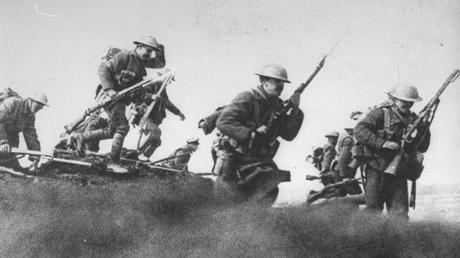
Battle of the Somme
The Battle of the Somme, which took place from July to November 1916, started as an Allied offensive against German forces on the Western Front and turned into among the most bitter and expensive battles of World War I.
British forces suffered over 57,000 casualties-including over 19,000 soldiers killed-on the first day of this battle alone, which makes it the single most devastating day in that country's military history. By the time the Battle of the Somme (sometimes referred to as the First Battle of the Somme) stopped almost five weeks later, over 3 million soldiers on both sides had fought at the conflict, and more than 1 million had been killed or hurt.
German
Before the assault, the Allies launched a week-long heavy artillery bombardment, using some 1.75 million shells, which aimed to cut the barbed wire guarding German defenses and destroy the enemy's positions. On the morning of July 1, 11 branches of the British 4th Army (many of these volunteer soldiers going into battle for the first time) started progressing on a 15-mile front north of the Somme. At exactly the exact same time, five French branches advanced on an eight-mile alongside the south, where the German guards were poorer.
Allied leaders were convinced the bombardment would harm German defenses so that their troops could easily progress. However, the barbed wire remained intact in several areas, and the German positions, many of which were deep underground, were stronger than expected. Along the line, German machine gun and rifle fire cut down thousands of the attacking British troops, many caught in no man's land.
Some 19,240 British soldiers were killed and over 38,000 wounded at the end of the first day-nearly as many casualties as British forces suffered when the Allies lost the battle for France during World War II (May-June 1940), including offenders.
Trench Warfare & War of Attrition
Other British and French forces had more success to the south, these gains were limited compared to the catastrophic losses sustained on this first day of conflict. But Haig was decided to press on with the offensive, and over the next two months, the British established a series of smaller attacks on the German line, placing increasing pressure on the Germans and forcing them to divert some soldiers and weapons from Verdun.
Early on the morning of July 15, British troops launched another artillery barrage followed by a gigantic assault, now on Bazentin Ridge, at the northern portion of the Somme. The attack took the Germans by surprise, and the British were able to progress some 6,000 yards into enemy territory, occupying the village of Longueval. But any little advance continued to come at the cost of heavy casualties, with the Germans losing 160,000 soldiers and the French and British more than 200,000 at the end of July.
Near the end of August, with German morale running low because of lost ground on the Somme and in Verdun, Germany's General Erich von Falkenhayn was replaced by Paul von Hindenburg and Erich Ludendorff. The control change marked a change in German plan: They'd construct a new defensive line behind the Somme front, conceding land but enabling them to inflict much more casualties on the advancing Allied troops.
Tanks Join the Battle
On September 15, during an assault at Flers Courcelette, the British artillery barrage was followed by an improvement of 12 branches of soldiers accompanied by 48 Mark I tanks, making their first-ever look on the battlefield. However, the tanks were still early in their growth phases, and several broke down before making it into the front line. Although the British were able to progress some 1.5 miles, they lasted some 29,000 casualties and fell short of a genuine breakthrough.
As October started, poor weather stymied another Allied assault, with soldiers fighting to cross muddy terrain under fierce fire from German artillery and fighter planes. The Allies made their final progress of the struggle in mid-November, attacking the German positions from the Ancre River valley. With the advent of true winter weather, Haig eventually called the offensive to a stop on November 18, finishing the struggle of attrition on the Somme, at least until the next year. Over 141 days, the British had advanced just seven miles and had failed to break the German line.
Legacy of the Battle of the Somme
More than anything else, the Battle of the Somme-and its catastrophic first day-could be remembered as the epitome of this brutal and apparently senseless carnage that characterized trench warfare during World War I. British officials, notably Haig, could be criticized for continuing the offensive notwithstanding such devastating losses.
Lots of the British soldiers who fought in the Somme had volunteered for military service in 1914 and 1915 and saw combat for the first time at the struggle. Many were members of so-called Pals battalions or components that were composed of friends, relatives and acquaintances in the same community. In one poignant example of a community's loss, some 720 men in the 11th East Lancashire battalion (called the Accrington Pals) fought on July 1 in the Somme; 584 were killed or hurt.
Despite its failure, the Allied offensive in the Somme did inflict considerable harm on German positions in France, spurring the Germans to retreat to the Hindenburg Line in March 1917 instead of continuing fighting over the same property that spring.
Although the precise number is disputed, German declines by the close of the Battle of the Somme probably exceeded Britain's, with a few 450,000 soldiers dropped compared with 420,000 on the side. The living British forces had gained invaluable experience, which would later help them achieve success on the Western Front.
Source: https://www.history.com/topics/world-war-i/battle-of-the-somme
